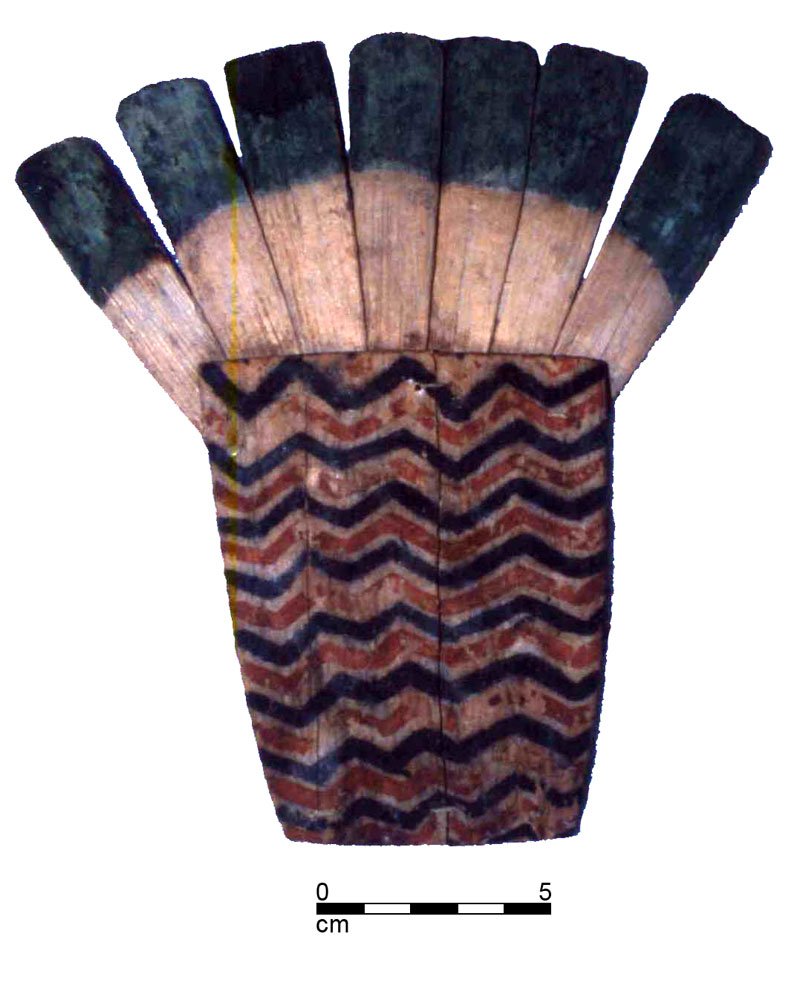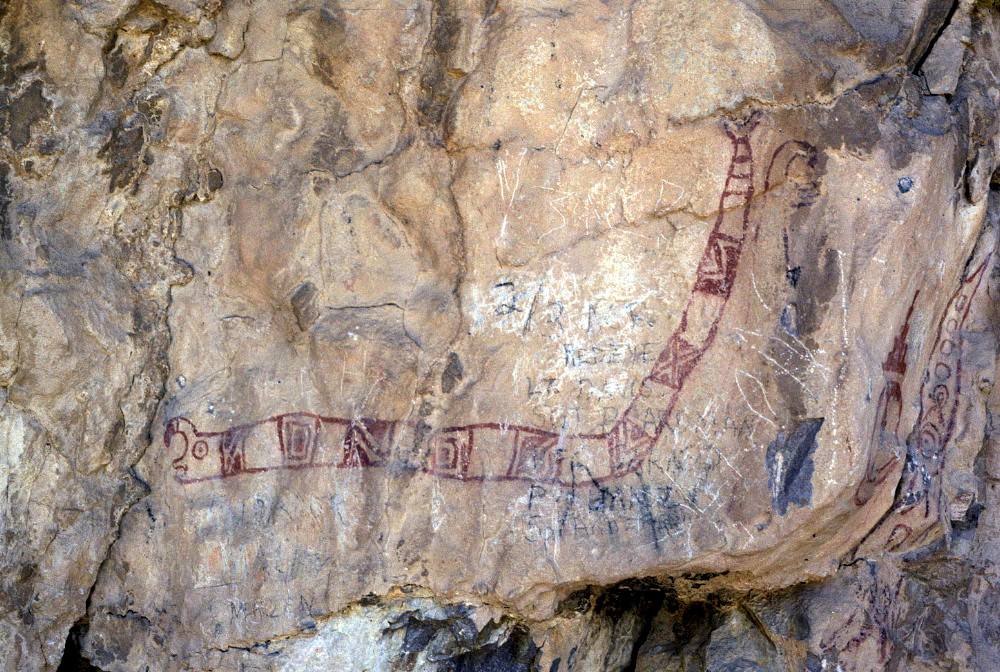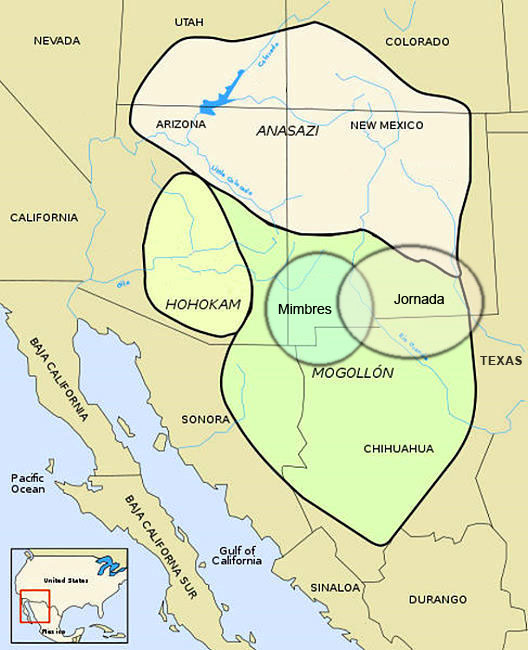Ceremonial Cave has long been regarded as one of the earliest examples of Southwestern shrine caves, its greater age being indicated by the quantities of items such as the darts and spears, so-called prayer sticks, and fending sticks, all of which are generally older than the kinds of objects more characteristic of later shrine caves. One of the few other comparably early shrine caves is the Correo Snake Pit, a Laguna Pueblo war shrine in central New Mexico. In contrast, the well known Mule Creek Cave in southwestern New Mexico is a good example of a Late Prehistoric shrine cave; it contained large numbers of bows and arrows, many of them in miniature, as well as pahos (prayer sticks), reed cigarettes, tablitas, figurines, and even mobiles. In many cases, shrine caves also have pictographs. The presence of some of these later kinds of objects at Ceremonial Cave indicates that this site continued to be used a shrine cave until very late in the prehistoric period.
There were several residential villages nearby in the Hueco bolson at all times during the use of Ceremonial Cave as a shrine, at least to the extent that it has been dated so far. Late in time, there was the village at Hueco Tanks and, during the Pueblo Period, there was the large Hot Well pueblo only a few miles away. One could presume that small contingents of pilgrims visited Ceremonial Cave and perhaps other nearby places like Picture Cave for religious rituals on many occasions over more than a millennium. If the fiber sandals so abundant at Ceremonial Cave relate to use of the cave as a shrine, the astonishing number of more than 1000 suggests many visits, apparently all or most by local individuals, if the distinctive Hueco scuffer-toe style of sandal is any indication.
Many of the objects from Ceremonial Cave reflect a distinctive Jornada Mogollon use of the shrine. The tablitas seem Jornada, but many of the other objects such as the turquoise encrusted bracelet, the Glycymeris bracelets, the shell beads, and the turquoise and shell pendants occur widely in the Southwest. The vermetid beads, however, come into the Jornada area after the establishment of Casas Grandes as a major center in northern Chihuahua southwest of modern El Paso. The iconography in the rock art in nearby Picture Cave shows linkage to the greater Jornada-Mimbres-Casas Grandes area in such features as the forward-pointing horn on the horned serpent pictographs.
Methodological Benefits
The CT scanning and AMS dating effort on the hafted spear points has provided direct information on particular point styles that delineates their chronological age range with greater precision and confidence than was hitherto possible. The dates on the three hafted Carlsbad points are relatively consistent at 2350-1730 B.P. or 400 B.C.-A.D. 220 (2 sigma calibration). This is consistent with previous age estimates of ca 1000 B.C.-A.D. 300 but is considerably tighter. Having dated either the foreshafts or sinew binding, this new dating can be assumed to reflect more accurately the true time period when the Carlsbad type was in use.
The single date so far on what is tentatively identified as a Hueco point is 3640-3480 B.P. or 1690-1530 B.C. (2 sigma calibration). If the point has been correctly typed, this date is several centuries earlier than what is generally thought for the Hueco type.
Dating the Use of Ceremonial Cave as a Shrine
One of the most obvious revelations of the CT scanning and AMS dating of the hafted spear points is that some of the items apparently placed in Ceremonial Cave as offerings are approximately 2000 years old whereas others are at least another 1000 years older. While it was clear from the basic atlatl/spear technology that many of the artifacts predate the introduction of the bow and arrow sometime around A.D. 800, there was no chronometric evidence for more specific dating of the use of Ceremonial Cave as a shrine until this project. A similar dating effort by Phil Geib targeting the large number of rabbit or fending sticks from Ceremonial Cave is in progress as is research by Geo-Marine, Inc,. on dating of the tablitas and other ritual objects as they relate more specifically the inception and fluoresence of Jornada style rock art. Even with the very modest number of AMS dates so far, it is abundantly clear that much can be learned about the history of Ceremonial Cave via a program of AMS dating of the large collection of artifacts with organic components.
Clearly, some of the unusual objects from Ceremonial Cave are substantially more recent in age than any of the spears and some can be confidently dated on stylistic grounds to around A.D. 1000, give or take a couple of centuries, and even to perhaps the A.D. 1400s. This includes the well known turquoise encrusted bracelet, much of the shell ornaments assemblage, in particular the Vermetid beads that likely came via Casas Grandes in Chihuahua. At present, we do not know if Ceremonial Cave was used as a shrine cave regularly in the intervening centuries, but an aggressive AMS dating program would likely determine this. In any event, we can say with some confidence that Ceremonial Cave was one of the earliest shrine caves anywhere in the greater Southwest.
|
|
We can now say with some confidence that Ceremonial Cave was one of the earliest shrine caves anywhere in the greater Southwest. |

Tablita headress from Mule Creek shrine site in New Mexico. The shrine held a wealth of ceremonial objects including miniature bows and arrows, which indicate a later use of the site than that of Ceremonial Cave. Photo by Darrell Creel  .
View other shrine objects from Mule Creek and Ceremonial Cave  . |

Distinctive rock art at nearby Picture Cave reflects cultural linkage to the greater Jornada-Mimbres-Casas Grandes area. Enlarge to see full panel. Photo by Darrell Creel  . |

Area of Jornada and Mimbres traditions within the greater Mogollon cultural area. The Mogollon, along with Hohokam and Anasazi, are is the three most well-defined cultures in the Southwest. Map adapted from Wikipedia  . |
Key ceremonial objects. The darts, fending stick, and pajo prayer sticks are particularly significant, indicating early use of Ceremonial Cave as a shrine. Many of the ornaments, including the turquoise bracelet, relate to the shrine's later Jornada use, as trade and interaction broadened within the greater Southwest. TARL Collections.  |
|